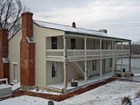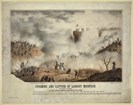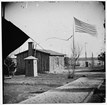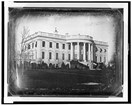An unknown 2nd Lieutenant in the U.S.-Mexican War later resigns the army. He rejoins and goes on to become lieutenant general of all Union armies. In his first term as President of the United States, he establishes Yellowstone National Park. From his first battle to his family home to his final resting place — the saga of Ulysses S. Grant is preserved in your National Parks.
-
Palo Alto Battlefield National Historical Park
Article 1: Grant at Palo Alto Battlefield

Ulysses S Grant fought on the field of Palo Alto in the first battle of the war. He fought alongside 2,300 other U.S. troops against 3,400 Mexican soldiers. Learn about his experience at this site. Read more
-
Article 2: Grant at Fort Vancouver

Following the US-Mexican War, Grant was shifted from post to post by the army. He married Julia Dent and celebrated the birth of his first child, but the need to protect the newly acquired Oregon Territory interrupted his relative domestic bliss. In the spring of 1852, Grant’s regiment was ordered West. Read more
-
Article 3: Grant at Fort Donelson

By 1862, Grant was a brigadier-general commanding over 27,000 troops. Grant decided to attack Fort Donelson to achieve his goal of capturing the Confederate stronghold of Nashville. Read more
-
Article 4: Grant at Vicksburg

In May of 1863, Ulysses S. Grant marched towards the final goal of his campaign: Vicksburg. Taking this Southern stronghold would allow the Union to control the Mississippi River and boost Northern morale. After a series of battles, Grant’s troops forced General Pemberton’s Confederate army to retreat into the defenses surrounding Vicksburg. Read more
-
Article 5: Grant at Lookout Mountain

Although Grant considered the battle at Lookout Mountain nothing more than a small skirmish, the Union victory freed General Hooker to join the main assault on Missionary Ridge the following day and forced the Confederates to retreat to Georgia. Read more
-
Article 6: Grant at Missionary Ridge

As the sun rose on November 25, 1863, Ulysses S. Grant looked out from his field headquarters on Orchard Knob and saw his plan to take Missionary Ridge and defeat the Confederates at Chattanooga spring into action. Read more
-
Article 7: Grant at the Wilderness

Grant hoped to march through a thickly wooded area known as the Wilderness so he could effectively use his cannon to fight on open ground near Spotsylvania Court House, Virginia. The outnumbered Confederates knew this and surprised Grant’s troops in the Wilderness thickets. Read more
-
Article 8: Grant at Richmond

Realizing he was fighting yet another stalemate, Grant looked towards Richmond. He set his sights on Old Cold Harbor, a key strategic area. For three days, the Union attacked. However, disorganization, unfamiliar terrain and battle-weary soldiers prevented them from breaking through the Confederate forces. Read more
-
Article 9: Grant on the Eastern Front

Grant’s initial assault on Petersburg ended with heavy casualties without any significant breakthroughs. Additional attempts also ended in failure. Facing a reinforced and entrenched enemy, Grant settled in for a siege, setting the stage for the longest and final major engagement of the Civil War. Read more
-
Article 10: Grant at Petersberg

In January 1865, Confederate Vice President Alexander Stephens and other Confederate officials approached Grant’s headquarters to discuss peace. They were escorted to a steamer where they waited for Union President Abraham Lincoln’s arrival. Despite his feelings, Grant was a gracious and courteous host. Read more
-
Article 11: Grant at Appomattox Court House

On April 9th, General Grant and his mud-splattered staff arrived at Appomattox Court House. They were in stark contrast to General Lee in his new uniform. In a fine brick home, the two men discussed the surrender terms. Lee’s surrender was the symbolic end of the Civil War. Read more
-
Article 12: Grant at President’s Park

Ulysses S. Grant began his residence at the executive mansion, now called the White House, on March 4, 1869. Flanked by regiments of Civil War veterans, including African American soldiers, his inauguration parade led him through cold and damp weather to Capitol Hill. Read more
-
Article 13: Grant and Yellowstone

On March 1, 1872, Grant signed the Yellowstone National Park Protection Act, which made the area “a public park or pleasuring-ground for the benefit and enjoyment of the people.” This landmark legislation created the first National Park and led to the creation of the National Park Service. Read more
-
Article 14: Grant’s Resting Place

On July 23, 1885, President Ulysses S. Grant died of throat cancer. Though he wanted to be buried at his alma mater, West Point, he rejected the idea because women could not be buried there. Instead, Grant had his wife, Julia Dent Grant, choose a burial site. She chose New York City, where the family had enjoyed living. Read more
